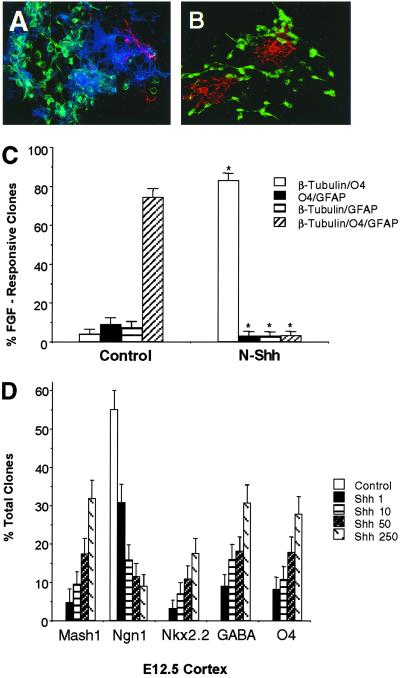Fig 2.
Shh promotes neuronal/OL lineage restriction of early embryonic forebrain stem cells and the selective induction of transcription factors involved in GABAergic neuronal and OL lineage specification and maturation. (A and B) Immunofluorescence micrographs of individual differentiated clones derived from E12.5 cerebral cortical cells after clonal expansion under control (bFGF, 10 ng/ml, A) and N-Shh (bFGF+N-Shh, 50 ng/ml, B) conditions for 3 DIV, and subsequent plating as intact clonal populations under differentiating conditions for an additional 6 DIV. Note that FGF-responsive clones are multipotent (neurons: β-tubulin, FITC; OLs: O4, cascade blue; astrocytes: glial fibrillary acidic protein, tetramethylrhodamine B isothiocyanate), whereas FGF+Shh-responsive clones are comprised of more lineage-restricted progeny (neurons: β-tubulin, FITC; OLs:O4, tetramethylrhodamine B isothiocyanate). (C) Comparative clonal lineage profiles of bFGF- and bFGF+Shh-responsive E12.5 cortical progenitor species plated and propagated under culture conditions as noted above. All data points represent the proportion of target clones with its 95% confidence interval. Statistical analysis was calculated by using χ2 analysis: *, P < 0.001 (compared with individual clonal lineage profiles in control condition). (D) Comparative proportion of individual clones containing Mash1, Neurogenin1, Nkx2.2, GABA, and O4 derived from primary E12.5 cortical progenitors in the absence and presence of increasing concentrations of Shh after 6 DIV. Statistical analysis was calculated by using χ2 analysis: P < 0.001 [for all data points relative to their control (Ngn1), or Shh, 1 ng/ml (Mash1, Nkx2.2, GABA, O4) conditions].

